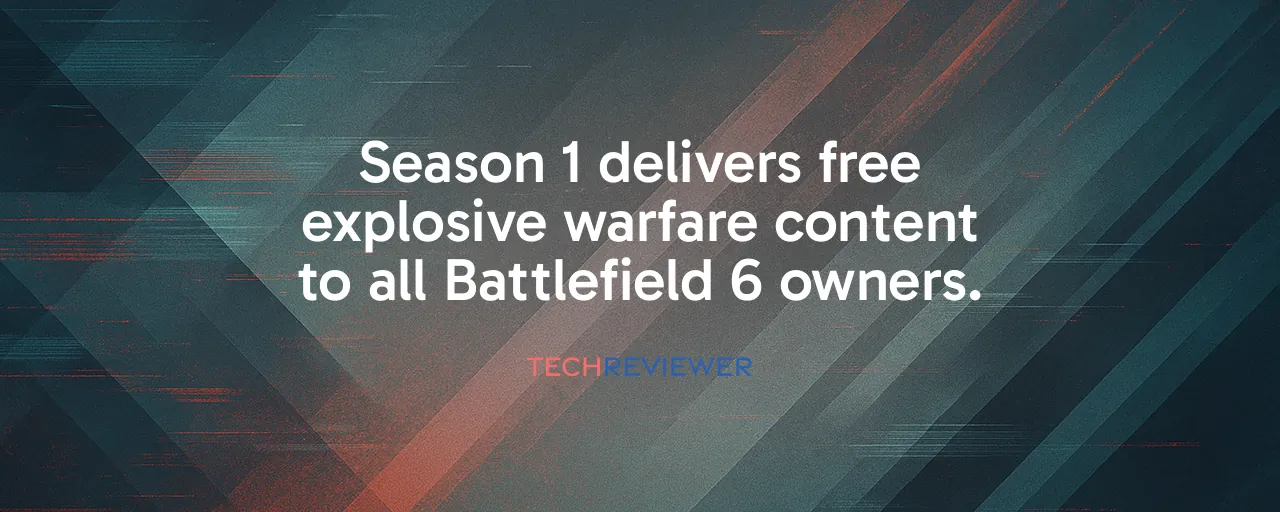A Fresh Start With Season 1's Explosive Content
Battlefield 6's Season 1, launching October 28, 2025, feels like a love letter to fans craving epic, large-scale warfare. Kicking off with Rogue Ops, players get Blackwell Fields, a sprawling new map, alongside the fast-paced Strikepoint mode and the Traverser Mark 2 vehicle. EA's promise of free monthly updates, including two more phases, California Resistance and Winter Offensive, signals a commitment to keeping the game vibrant without splitting the community. With over seven million copies sold in just three days, the hype is real, and Season 1 aims to keep players hooked.
Unlike past entries, this season's rollout leans heavily on accessibility. Every new map, weapon, and mode comes free to anyone who owns the game, a stark contrast to the paid DLCs of yesteryear. The approach mirrors lessons from Call of Duty Warzone, where free content fueled long-term engagement, but EA's focus on classic Battlefield chaos, think tanks rolling through crumbling buildings, sets it apart. It's a bold move to win back players burned by Battlefield 2042's rocky launch.
Tech That Brings Battlefields to Life
Underpinning Season 1's ambition is the revamped Frostbite engine, which delivers jaw-dropping visuals and gameplay depth. The Kinesthetic Combat System lets players lean around corners, hitch rides on vehicles, or drag wounded squadmates to safety, adding tactical flair to every firefight. Tactical Destruction makes environments feel alive, walls shatter realistically, forcing quick strategic shifts. These advancements make Blackwell Fields more than a map; it's a dynamic playground where every match feels unique.
The game's tech also shines in its scalability. With NVIDIA's DLSS 4 boosting frame rates up to 3.8 times at 4K, even mid-range PCs can handle the chaos, while high-end rigs like the RTX 5090 achieve over 740 FPS at 1080p Ultra with DLSS 4 enabled. Modular installs shrink the game's footprint to as low as 55 GB, addressing player gripes about bloated file sizes. This focus on accessibility ensures Season 1's content reaches a wide audience, from casual players to hardcore enthusiasts.
Learning From the Past, Building for the Future
Battlefield 2042's launch in 2021 was a wake-up call, sparse content and technical woes alienated fans. EA responded by uniting four studios under Battlefield Studios, blending DICE's multiplayer expertise with Criterion's vehicle prowess and Ripple Effect's live-service savvy. The result? A polished launch with 172 million matches played in three days and a Steam peak of 769,000 concurrent players. Season 1's clear roadmap, with specific dates and content like Eastwood's map and Sabotage mode, shows EA learned to prioritize transparency.
Compare that to Warzone's triumph, where consistent updates and a free-to-play model built a loyal player base. Battlefield 6 borrows the free-content playbook but sticks to its roots with squad-based, large-scale battles. Yet, challenges remain, mixed reviews of the single-player campaign and credit disputes among developers highlight growing pains. Season 1's success hinges on delivering on its promises without the stumbles of past live-service efforts.
Empowering Players With Creative Control
What makes Season 1 stand out is the Portal Builder Tool, letting players craft custom maps and modes with all new content, from Blackwell Fields to the Ice Lock Empire State event map. This tool turns players into creators, extending the game's life through community-driven experiences. Imagine a fan-made mode where tanks dominate a collapsing skyscraper, it's possible, and it keeps the game fresh long after Season 1 ends.
This approach echoes Apex Legends' success, where EA nurtured community engagement to sustain momentum. By giving players tools to shape their own battlefields, EA fosters a sense of ownership, unlike Warzone's more developer-driven updates. Still, the Battle Royale mode's launch timing remains unconfirmed, despite rumors and September 2025 testing suggesting it's coming, leaving players wondering when it will arrive. If it lands, it could expand the game's reach, drawing in players hesitant about the $70 price tag.
Balancing Hype With Long-Term Trust
Season 1's free content and technical polish have sparked excitement, with critics giving an 83/100 on OpenCritic and 92% recommending the game. But not everyone's sold, some reviewers call the single-player campaign uneven, and developer credit disputes have stirred debate. EA must navigate these hurdles while proving its live-service model can sustain momentum beyond the launch buzz. Players burned by unfulfilled roadmaps in games like Anthem are watching closely.
The stakes are high in a crowded market. Warzone and Apex Legends thrive by keeping players engaged with regular updates, and Battlefield 6 must match that cadence to compete. With cross-platform play uniting PS5, Xbox, and PC players, and anti-cheat measures like TPM 2.0 ensuring fairness, EA has the tech to succeed. The real test is whether Season 1's monthly drops can maintain the community's trust and keep the battlefields alive.
